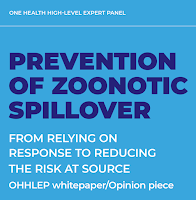
#17,306
Whether we are discussing avian or swine influenza, MERS-CoV, Nipah, Zika, Langya, Ebola, or Lassa Fever, all of these diseases (and many more) are zoonotic; they occur naturally in non-human hosts, but occasionally spill over into humans.
Even long standing human diseases, like measles or tuberculosis, began in animals. It wasn't until mankind began raising livestock that many of these diseases began to impact humans (see The Third Epidemiological Transition).
In 2014, in Emerging zoonotic viral diseases L.-F. Wang (1, 2) * & G. Crameri wrote:
The last 30 years have seen a rise in emerging infectious diseases in humans and of these over 70% are zoonotic (2, 3). Zoonotic infections are not new. They have always featured among the wide range of human diseases and most, e.g. anthrax, tuberculosis, plague, yellow fever and influenza, have come from domestic animals, poultry and livestock. However, with changes in the environment, human behaviour and habitat, increasingly these infections are emerging from wildlife species.
It has only been in recent years that the idea that animal health and human health are inexorably intertwined has become widely recognized, and that to prevent the spill overs of zoonotic diseases - and potential pandemics - requires the adoption of a comprehensive `One Health' strategy.
Yesterday the WHO published an 18-page position paper on the prevention of zoonotic spillover. I've reproduced the summary below, but you'll want to follow the link to read it in its entirety.Overview
The devastating impact of COVID-19 on human health globally has prompted extensive discussions on how to better prepare for and safeguard against the next pandemic. Zoonotic spillover of pathogens from animals to humans is recognized as the predominant cause of emerging infectious diseases and as the primary cause of recent pandemics.
This spillover risk is increased by a range of factors (called drivers) that impact the nature, frequency and intensity of contact between humans and wild animals. Many of these drivers are related to human impact, for instance, deforestation and changes in land use and agricultural practices. While it is clear that the triad of prevention-preparedness-response (P-P-R) is highly relevant, there is much discussion on which of these three strategic activities in the field of emerging infectious disease should be prioritized and how to optimally target resources. For this, it is important to understand the scope of the respective activity and the consequences of prioritization.
PREVENTION OF ZOONOTIC SPILLOVERFROM RELYING ON RESPONSE TO REDUCING THE RISK AT SOURCE OHHLEP whitepaper/Opinion pieceAuthored by the members of the One Health High-Level Expert Panel (OHHLEP): Wanda Markotter*, Thomas C. Mettenleiter*, Wiku B. Adisasmito, Salama Almuhairi, Casey Barton Behravesh, Pépé Bilivogui, Salome A. Bukachi, Natalia Casas, Natalia Cediel Becerra, Dominique F. Charron, Abhishek Chaudhary, Janice R. Ciacci Zanella, Andrew A. Cunningham Osman Dar, Nitish Debnath, Baptiste Dungu, Elmoubasher Farag, George F. Gao, David T. S. Hayman, Margaret Khaitsa, Marion P. G. Koopmans, Catherine Machalaba, John S. Mackenzie, Serge Morand, Vyacheslav Smolenskiy, Lei Zhou *Corresponding authors
